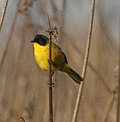Taxonomy
The genus Geothlypis was introduced in 1847 by the German ornithologist Jean Cabanis. [2] [3] This was a replacement name for Trichas that had been introduced in June 1827 by William Swainson but was pre-occupied by Trichas that had been introduced in March 1827 by C. L. Gloger for a genus in a different family. Swainson had introduced his genus to accommodate a single species, Tichas personatus Swainson. This is the type species and is a junior synonym of Turdus trichas Linnaeus, the common yellowthroat. [3] [4] [5] The genus name Geothlypis combines the Ancient Greek γεω-/geō- meaning "ground-" or "earth-" with θλυπις/thlupis, an unknown small bird. [6]
The taxonomy of these closely related species is complicated, and it is sometimes difficult to define which forms merit species status. For example, common yellowthroat, Belding's yellowthroat, Altamira yellowthroat, and Bahama yellowthroat are sometimes considered conspecific. Conversely masked yellowthroat can be split to three or even four species. The name 'yellowthroat' is sometimes used as an alternate name for the yellow-throated leaflove. [7]
The geographical isolation of the various populations of this mainly sedentary group has led to its genetic divergence and speciation. This process can be seen in action in the case of masked yellowthroat, where the subspecies are separated by rainforest or the Andes, leading to the development of distinctive forms, such as the Central American race Geothlypis aequinoctialis chiriquensis. This form is found in the highlands of Costa Rica and western Panama, and is separated by 1000 km from its South American cousins, from which it differs in size, appearance and vocalisations.
The Kentucky warbler, mourning warbler, and MacGillivray's warbler, all previously thought to have been members of the genus Oporornis , have since been moved to Geothlypis. [8]
Description
All the yellowthroats have similar plumage, with yellow-green upperparts, yellow breast, and a mainly black bill. The adult male has a black facemask of variable extent, usually bordered above with a grey band. The female is similar, but lacks the black mask, and may be duller in plumage.
Behaviour
The breeding habitat of these warblers is typically marshes and other wet areas with dense low vegetation. The eggs, two in most species, but up to five for common yellowthroat, are laid in a lined cup nest low in grass or rank vegetation.
Yellowthroat are usually seen in pairs, and do not associate with other species. They are often skulking, and feed on a range of insects.
This page is based on this
Wikipedia article Text is available under the
CC BY-SA 4.0 license; additional terms may apply.
Images, videos and audio are available under their respective licenses.















